This section provides the general protocol for transduction of mammalian cells with VSV-G packaged lentiviral particles. This protocol was developed and optimized using HEK293 and K-562 cells, and has been successfully used with many other common cell types. However, each cell is different and, depending on the characteristics of your specific cells, some optimization may be necessary.
Lentiviral transductions are performed by mixing cells and virus in culture media. For both adherent and suspension cells, transductions are initiated in suspension and carried out overnight. Adherent cells are allowed to adhere to substrate during transduction and are transduced at a cell density that allows for 2-3 population doublings before reaching confluence. Suspension cells are typically transduced at a higher density than standard growth density, and then they are diluted to standard growth density 18-24 hours after transduction. Do not let cells become too dense or let the medium become yellow at any point.
Before transduction, seed and expand cells from frozen stocks. Cells should be actively growing.
Day 0—Inoculate Cells
- Quickly thaw the lentiviral vector particles in a water bath at 37°C. Transfer the thawed particles to a laminar flow hood, gently mix by rotation, inversion, or gentle vortexing, and keep on ice. Unused viral particles can be aliquoted, refrozen at -80°C, and used again for subsequent experiments. There will be some loss of viral activity (usually 10-20%) with each refreeze.
- Suspend sufficient cells for transduction in appropriate complete media supplemented with 1 μl/ml LentiTrans™ Transduction Reagent—if cells are sensitive to the LentiTrans Reagent, use a lower concentration or omit it. For HEK293 cells, we usually suspend at a density of 1 × 105 cells/ml in D-MEM supplemented with 10% FBS and LentiTrans Reagent. For K-562 cells, we usually suspend at a density 2 × 106 cells per ml in RPMI/10%FBS supplemented with 20mM HEPES, pH 7.4 and LentiTrans Reagent.
- Aliquot cells into wells or plates. For small scale transductions or titering assays, cells may be plated into multiwell microtiter plates (e.g., 0.5 ml/well for 24-well plates or 1 ml/well for 12-well plates). To transduce larger numbers of cells, use larger plates and scale up the volume accordingly
- To each plate, add an appropriate amount of lentivirus. The amount of virus will depend on your viral titer and your experiment. Refer to the Transduction Guidelines or Assay Procedures section of the product manual for application specific recommendations.
- Close the plate and mix by gentle agitation:
- For adherent cells, place the plate into the CO2 incubator and grow cells under standard conditions for 16-24 hours.
- For suspension cells only, “spinoculate” by wrapping the perimeter with parafilm, placing the plate into the centrifuge with an appropriate balance, and spin the cultures at 1,200 × g at +25°C for 2 hours. Following centrifugation, remove plate(s) from centrifuge, carefully remove parafilm, and place in incubator. After 3 hours, “feed” cells with 0.5 ml additional complete medium per well (no LentiTrans Reagent).
Day 1—Change Media
Between 16 to 24 hours post-transduction, remove media and replace with fresh complete media without LentiTrans Reagent. For suspension cells, spin down and resuspend cells in complete media at 1-5 × 105 cells/ml. Place in incubator and grow for an additional 24-48 hours. Avoid confluency or too high a density of cells during and after transduction. If necessary, replate.
Day 3 or 4—Harvest or Split Cells
At about 72 hours after adding virus, you may expand cells as normal or harvest cells for an assay. To continue growing cells, split the cells 1:4 to 1:8 (or as appropriate, depending on the type of cells) as the culture approaches confluence, and add complete medium. As required by your experiments add antibiotics, other factors (tetracycline), etc., and expand as normal.
Need more help with this?
Contact Us

